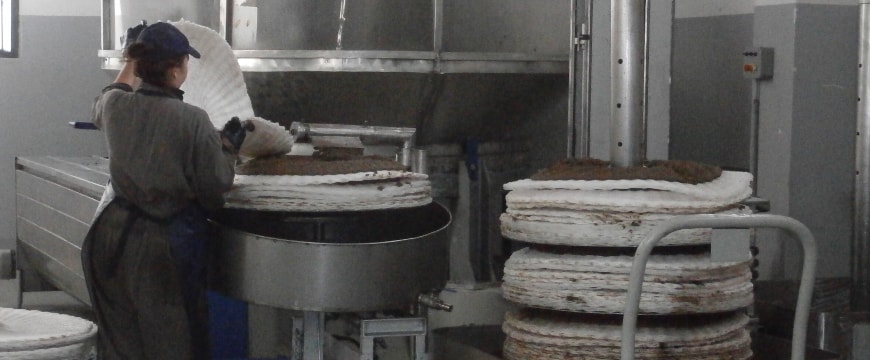Olives enter the olive receiving area on conveyor belts for separation from leaves and branches and then enter the mill. They may be washed either outside or inside the mill. In both traditional and modern mills, olives are ground or crushed into a paste which is pressed or churned to release oil that must then be separated from other liquids and solids.
Traditional stone mills have become rare in Greece, but they still exist in an updated form, for example at Biolea’s Astrikas Estate near Kolymvari, Crete. Stone mills grind the olives under giant revolving mill wheels that create an olive paste. At Biolea, that paste is distributed on pressing filters that are stacked high on pressing carts and inserted in a traditional olive press for cold pressing for about 40 minutes. As the pressing filters full of olive paste are pressed using hydraulic pressure, olive oil and juices are visible running down the sides.
At Biolea, the juice is gathered in the bottom of the pressing carts and pumped up to a wall tank behind the press, where it is left to sit another 40 minutes in order for most of the olive oil to separate naturally (and rise to the top). After 40 minutes, the liquid at the bottom of the tank is passed through a centrifugal separator that uses centrifugal force to extract whatever olive oil is left in the vegetable water, while the olive oil that has already risen to the top is gathered just as it is, without passing it through separators or filters.
Modern olive mills use stainless steel crushers (or hammer mills) and machinery in place of a stone mill and traditional press. Olives are still crushed into a paste at a carefully controlled low temperature, 27 degrees Celsius (80.6 degrees Fahrenheit) or less, since this cold extraction preserves the nutrients, flavors, and aroma in the olive oil. After crushing, the olive paste undergoes malaxation, a kneading or churning that enables the small olive oil droplets to combine into larger ones, for about 30 minutes (depending on the maturity level and variety of the fruit).
Next, the olive paste undergoes centrifugation: the liquids are separated from the solids using centrifugal force while spinning in decanters. In two-phase centrifugation, olive oil and a very damp olive pomace (paste) are produced. In three-phase centrifugation, water is added, then water, oil, and solids are separated from each other. Most olive oil is then filtered to remove impurities, although some oil is simply left in the vats for some time so the sediment can settle to the bottom before bottling (in a process called racking or purging).
For captioned photos that illustrate this process, see Olive Oil Production in the Photo Gallery. For a more detailed discussion of the following topics, see Olive Oil Source’s website:



